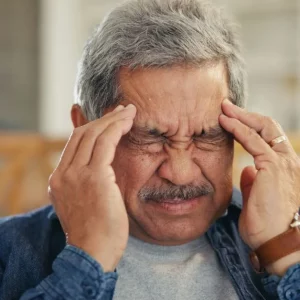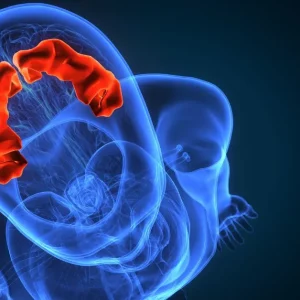Dementia refers to a loss of cognitive abilities such as memory, decision-making, and problem-solving. It’s most commonly caused by Alzheimer’s disease, but strokes can cause dementia too — specifically vascular dementia.
To help you understand post-stroke dementia, this article will discuss:
- How can a stroke cause dementia?
- What is the risk of vascular dementia after stroke?
- What are the signs and symptoms of post-stroke dementia?
- Can you treat dementia after stroke?
- Other tips for dementia management
- Is there medication for post-stroke dementia?
- How do you care for someone with dementia?
How can a stroke cause dementia?
To understand how a stroke can cause dementia, let’s look at the connection between the brain, the arteries, and a stroke.
A stroke occurs when the supply of blood in the brain becomes disrupted by either a clogged or burst artery. When brain cells do not receive enough blood, they are deprived of oxygen and other essential nutrients, which can lead to brain damage. For this reason, a stroke requires swift medical attention to restore normal blood flow in the brain and save the person’s life.
The health of your arteries has a direct impact on your risk of stroke. When blood can flow freely through clear arteries, the risk of stroke is low. The risk of stroke increases when arteries become narrowed or damaged from conditions like atherosclerosis, high blood pressure, or diabetes.
But how can a stroke cause dementia? When a stroke causes damage to the brain, it can cause a variety of secondary effects including vascular dementia.
Vascular dementia occurs when the brain does not receive enough blood and thus causes damage to cognitive functions such as memory and problem-solving.
What is the risk of vascular dementia after stroke?
Vascular dementia could be caused by a stroke or other conditions that impact the supply of blood in the brain, such as poor circulation.
A person’s risk of post-stroke dementia increases with the number of strokes they experience. For example, a large study of over 5,000 stroke survivors found that the rate of vascular dementia was around 9% in those who had only suffered one stroke. In those who had experienced more than one stroke, however, the rate increased to 25%. The risk of vascular dementia also increases with age.
Because a stroke is a vascular disease that impacts the arteries, the same factors that increase the risk of stroke also increase the risk of vascular dementia. This means that conditions like high blood pressure, diabetes, and high cholesterol all increase the risk of vascular dementia.
Not all strokes cause vascular dementia, though. Every stroke is different and every person experiences different effects following a stroke. For example, a massive stroke may cause paralysis while very mild strokes may not cause any noticeable secondary effects at all.
However, just because a person does not experience many effects after a stroke does not mean they won’t develop vascular dementia. The best way to reduce the risk of vascular dementia is to improve the health of your arteries and blood flow by managing any vascular diseases such as hypertension and diabetes.
What are the signs and symptoms of post-stroke dementia?
Each area of the brain controls different functions. Therefore, the symptoms of vascular dementia vary between individuals depending on how the brain has been affected.
Some symptoms of vascular dementia can include:
- Confusion
- Difficulty with concentration and following a conversation
- Language problems, such as aphasia
- Memory loss
- Problems with planning, problem-solving, and decision-making
- Restlessness and agitation
- Disorganized thoughts and actions
- Depression
- Rapid mood swings
It’s important to note that some of these symptoms alone, such as mood swings, do not necessarily signify the presence of post-stroke dementia. Many of these symptoms, when occurring alone, are common cognitive effects of a stroke. However, when many cognitive effects occur together, a doctor may diagnose it as vascular dementia.
Can you treat dementia after stroke?
With vascular dementia, there is hope for improvement through cognitive rehabilitation, which is possible thanks to neuroplasticity.
Neuroplasticity is the process the brain uses to rewire itself and form new connections, as well as strengthen existing connections. When part of the brain sustains damage after a stroke, neuroplasticity allows healthy areas of the brain to take over. However, it does not occur without your help.
In order for neuroplasticity to work, the brain needs to see a demand for a function. For example, the brain won’t improve at the skill of riding a bike unless you attempt to ride a bike in the first place, because this shows a demand for that function. To apply this concept to cognitive health, this is where cognitive rehabilitation exercises come into play.
Cognitive exercises draw upon desired thinking skills, such as memory and attention. When the brain sees a demand for these skills, it will attempt to adapt. For example, by practicing memory exercises, the brain perceives the demand for the function of memory, and it responds by creating and strengthening neural pathways responsible for memory.
A Speech-Language Pathologist is a great resource for cognitive rehabilitation. Working alongside an SLP can be of great help for stroke survivors with dementia. Furthermore, cognitive training apps can provide access to therapy right from your phone. We recommend the CT Speech & Cognitive Therapy App because it was developed by SLPs and provides access to over 100,000 evidence-based cognitive exercises.
Other tips for dementia management
In addition to cognitive rehabilitation, increasing blood flow to the brain can sometimes help improve cognitive function. Here are a few ways to increase cerebral blood flow:
- Try aerobic exercise. Aerobic exercise is one of the best ways to boost blood flow, which will bring more oxygen and nutrients to your brain cells and increase cognitive function. Examples of aerobic exercise include activities such as brisk walks, swimming, and bicycling.
- Lower your blood pressure. High blood pressure constricts your arteries, making it more difficult for blood to flow up to the brain. Lowering your blood pressure causes the blood vessels to dilate, which can then allow more blood to reach the brain. Decreasing your blood pressure also reduces your risk of a second stroke.
- Stay hydrated. Blood is largely made up of water. Therefore, when you are dehydrated, your blood will thicken and have a harder time moving through your arteries. Staying hydrated then will thin the blood, increase blood flow, and reduce your risk of blood clots.
These tactics can all help treat the underlying cause of vascular dementia after stroke and potentially reverse at least some of the symptoms.
Is there medication for post-stroke dementia?
While there are no medications designed specifically for vascular dementia, some drugs used on individuals with Alzheimer’s disease have shown promise. Alzheimer’s is a form of dementia, and thus shares many characteristics with vascular dementia.
One drug that may prove useful for stroke survivors is memantine. Memantine, also known as Namenda, is used to treat the effects of Alzheimer’s disease and other forms of dementia. It does not cure these disorders, but it can slow their progression and improve certain cognitive skills such as memory and awareness.
However, memantine seems to have more effect in the early stages of vascular dementia, in that it slows down the progression. Therefore, if the patient’s dementia is advanced, this drug may not be as useful. Talk to your physician for more information on the benefits and risks of memantine for post-stroke dementia.
How do you care for someone with dementia?
Caring for a patient with vascular dementia can be a challenging experience. But there are ways to make things a little easier for both you and your loved one:
- Establish a routine. A calm environment can reduce worry and agitation, which in turn helps the person cope with their dementia. Establishing a daily routine that includes comfortable activities can help create this calm environment and take some pressure off you as well.
- Help them with cognitive rehabilitation. If your loved one struggles with memory or attention, they may not do cognitive rehab on their own. Instead, you may need to help them with their exercises. If this becomes too frustrating, remember to take care of yourself too.
- Find a support group. Caring for someone with post-stroke dementia can be a full-time job, and this can lead to social isolation. Support groups put you in touch with people going through the same experiences and give you a network you can rely on for help and advice.
- Take time for yourself. To avoid caregiver burnout, it’s important to take time to care for your own needs. If possible, have another family member take over your caregiving duties for the day and allow yourself time to recharge.
Following these tips can help lighten the burden a little and make the caregiving process smoother.
Understanding the connection between stroke and dementia
While not every stroke survivor will experience dementia, loss of blood flow to the brain can increase the person’s risk of cognitive decline.
However, by practicing cognitive rehabilitation and making certain lifestyle changes, patients can improve their symptoms and even slow vascular dementia’s progression.
Finally, always remember that even with post-stroke dementia, it is still possible to live a happy and fulfilling life. Although the road ahead might look difficult, it’s important to maintain hope.









